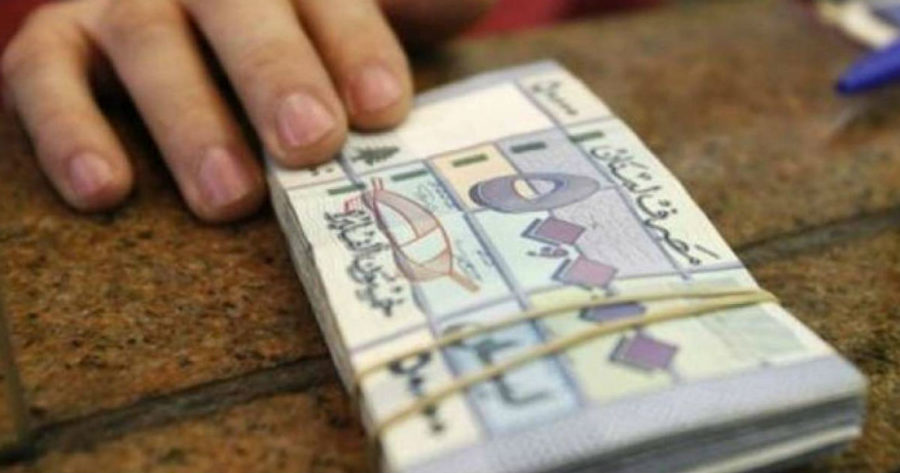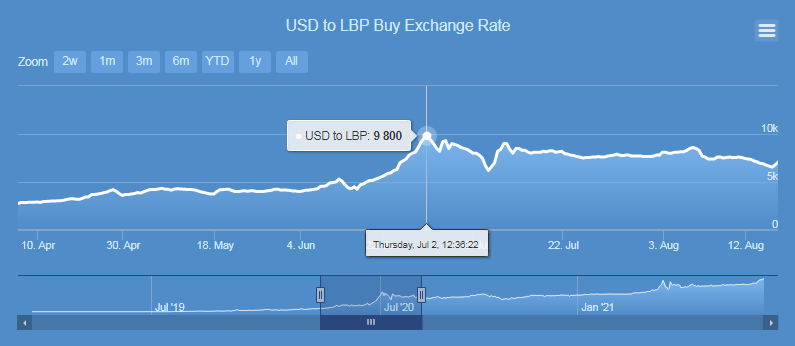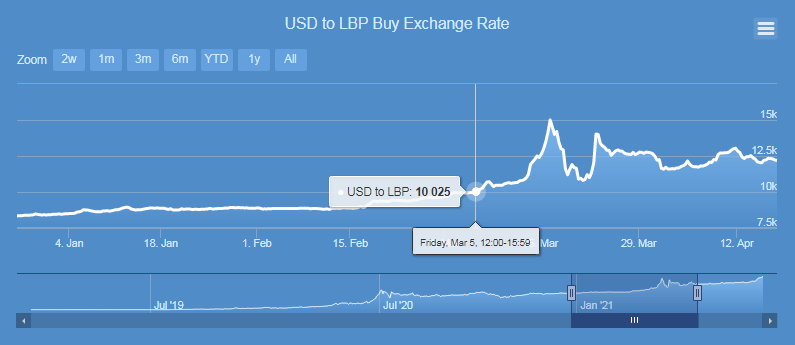
Lebanon is on the verge of a significant and sharp currency devaluation episode. According to data from Lirarate.org, which has been tracking the price of the dollar against the Lebanese Lira since the beginning of 2019, the black market dollar exchange rate might be signaling a sharp increase in price in the coming weeks.
If the financial and economic situation of Lebanon remains as is, the dollar exchange rate could reach up to new highs of 20,000 L.L/$ at least and up to 30,000L.L/$ at the extreme case. The likelihood of such a move in the price occurring is very high in the coming days or weeks, especially since there are no significant reforms on the horizon that could signal the inflow of additional foreign currency to the market from abroad. But what is the reason for this imminent price increase?
The black market rate of the US dollar in the Lebanese market is purely an indicator of supply and demand. When the supply of Liras in the market increases, the price of the dollar increases and vice versa. The steady increase in the dollar price over the past year has been due to people’s money withdrawals from their savings accounts that are being provided in Liras instead of dollars at the rate of 3900L.L/$. Another reason is the public sectors salaries that continue to be paid monthly using newly minted Lebanese Lira notes provided by the central bank. The reason is that the government income from duties and taxes has sharply declines due to the corona crisis which paralyzed the Lebanese economy, as it has many economies across the globe in the past year. According, the dollar exchange rate will continue to rise with no limit in sight, either in the short or medium term.
Everything previously mentioned is evident when looking at the USD to LBP exchange rate chart prepared by Lirarate.org. These values were observed and recorded since the beginning of 2019 and continue to be updated according to daily black market price signals which are taken from several geographical areas across Lebanon.

On July 2nd, 2020, the black market dollar exchange rate saw its first case of a sharp and quick increase. This is known as panic buying market. It usually occurs when the market rushes to buy large amounts of a currency, stock, or commodity causing its price to increase significantly against the local currency. In response, the remaining market participants rush to buy more of that currency or asset in order to quickly get rid of the depreciating currency they hold at any available price. This process usually ends in rapid and strong currency devaluation (in this case: the Lebanese Lira).
On June 14th 2020, the dollar price was at a low of 4250 L.L/$ when the Lebanese market went into a state of panic and began purchasing dollars at exorbitant prices. This pushed the price to a peak of around 9800L.L/$ in just 14 days on July 2nd.

On the 5th of March of 2021, the dollar price reached 10,000L.L for the first time, recording a new all-time high. It had taken over 8 months for the price to surpass the prior all-time high. What happened next was a repeat of the same episode. By the 16th of March, 11 days later, the price had skyrocketed from 10,000L.L to 15,000L.L! It was an increase of about 50% in less than 2 weeks.
In both cases seen above, after the panic dissipated, the dollar price quickly retraced back to previous levels. This would happen due to the sudden removal of Lira supply from the market, as people no longer have any cash in hand to use for exchange. This is the indicator that the price has reach its top. But what ultimately causes this sudden surge in exchange rate in Lebanon?
As we have mentioned before, the exchange rate is dictated by a free market of supply and demand. Since the dollar supply in Lebanon is limited and predictable in comparison to the Lira supply, it is the Lira supply that dictates the price, as market demand is generally steady. As a result, those who possess the highest amounts of cash are the ones who can affect the exchange rate the most. The majority of the Lira supply is controlled by 2 institutions, the banks and the commercial institutions (especially the commodity suppliers). While banks are somewhat highly regulated, with certain exceptions when it comes to political cover, commercial institutions’ participation in the black market exchange amounts to many millions of dollars on a daily basis. This is essential for their businesses that rely heavily on imported products that have to be paid for in USD. These institutions collect the sum total of their sales every single day and convert them to USD through the black market, sucking up the majority of daily dollar supply and often causing increase in rates.
This is the key to understanding the changing rates and the rapid fluctuations in the dollar price, but how and when does it happen?
As these institutions continue to sell their products for Lebanese Lira and exchanging them for dollars in the black market, they need to replenish their stocks. Due to the constant changes in price, they have to perform certain economic calculations that can predict what the exchange rate will be at the end of the cycle. According to that, they set their prices and maintain their profits. When they exchange rate is at an all-time high, these companies are unable to predict the price in the future due to the lack of frame of reference. Any incorrect calculation or prediction would render their entire sales period to pure loss, as they might not have enough revenue to even replenish their stocks.
In this case, these institutions are forced to suspend stock replenishment until a further time in which they can accurately predict the future price and ensure their business would at the very least break even.
This usually occurs when the exchange rate is at an all-time high, and the market has not decided on a price range. Consequently, these institutions continue to sell their existing stock, and buying dollars at current exchange rates. However, this time they simply hoard them and bide their time.
This phenomenon occurs simultaneously across the entire market. Soon afterwards, dollars supplies start to shrink, the economy slows down due to the suspension of imports, and the exchange rate begins to crawl up. This happens slowly until panic sets in. When panic sets in, the market rushes to buy up dollars in a frantic way causing a sharp and sudden devaluation of the local currency. This increase in prior instances has been above 50% and 100%. This buying wave ends when the Lira liquidity temporarily dries and allows the market time to escape the state of panic during which new dollar supplies emerge from individuals and institutes who are tempted by the very high rates. This then causes the price to retrace back almost as quickly as it rose.
When this happens, the price range from beginning of the move till the end would constitute the exchange rate for the next several months. According to these prices, institutions then are able to make their economic calculations, and set the prices at which they will be conducting business profitably.
The effects of this are often seen by people in stores and shopping malls. The prices are set according to the upper limit of exchange rate. These prices tend to remain high regardless of any further decreases in the exchange rate.
Today, the black market exchange rate hit 15500 L.L/$, setting a new record for several days in a row. In the next weeks or days, a large price move is expected that will be swift and sharp to the upside. This will mark the beginning of a new economic cycle in Lebanon, and as before, the upper limit will turn a lot of heads once more.

